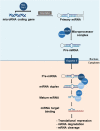RNA-Based Antipsoriatic Gene Therapy: An Updated Review Focusing on Evidence from Animal Models
- PMID: 38681207
- PMCID: PMC11055533
- DOI: 10.2147/DDDT.S447780
RNA-Based Antipsoriatic Gene Therapy: An Updated Review Focusing on Evidence from Animal Models
Abstract
Psoriasis presents as a complex genetic skin disorder, characterized by the interaction between infiltrated immune cells and keratinocytes. Substantial progress has been made in understanding the molecular mechanisms of both coding and non-coding genes, which has positively impacted clinical treatment approaches. Despite extensive research into the genetic aspects of psoriasis pathogenesis, fully grasping its epigenetic component remains a challenging endeavor. In response to the pressing demand for innovative treatments to alleviate inflammatory skin disorders, various novel strategies are under consideration. These include gene therapy employing antisense nucleotides, silencing RNA complexes, stem cell therapy, and antibody-based therapy. There is a pressing requirement for a psoriasis-like animal model that replicates human psoriasis to facilitate early preclinical evaluations of these novel treatments. The authors conduct a comprehensive review of various gene therapy in different psoriasis-like animal models utilized in psoriasis research. The animals included in the list underwent skin treatments such as imiquimod application, as well as genetic and biologic injections, and the results of these interventions are detailed. Animal models play a crucial role in translating drug discoveries from the laboratory to clinical practice, and these models aid in improving the reproducibility and clinical applicability of preclinical data. Numerous animal models with characteristics similar to those of human psoriasis have proven to be useful in understanding the development of psoriasis. In this review, the article focuses on RNA-based gene therapy exploration in different types of psoriasis-like animal models to improve the treatment of psoriasis.
Keywords: animal model; gene therapy; miRNA; psoriasis; siRNA.
© 2024 Lin et al.
Conflict of interest statement
The authors declare no competing interests in this work.
Figures




Similar articles
-
Targeted siRNA Therapy for Psoriasis: Translating Preclinical Potential into Clinical Treatments.Immunotargets Ther. 2024 May 16;13:259-271. doi: 10.2147/ITT.S458800. eCollection 2024. Immunotargets Ther. 2024. PMID: 38770264 Free PMC article. Review.
-
Mild electrical stimulation with heat shock reduces inflammatory symptoms in the imiquimod-induced psoriasis mouse model.Exp Dermatol. 2018 Oct;27(10):1092-1097. doi: 10.1111/exd.13720. Epub 2018 Jul 30. Exp Dermatol. 2018. PMID: 29928760
-
Implantable synthetic cytokine converter cells with AND-gate logic treat experimental psoriasis.Sci Transl Med. 2015 Dec 16;7(318):318ra201. doi: 10.1126/scitranslmed.aac4964. Sci Transl Med. 2015. PMID: 26676608
-
Combining network pharmacology, RNA-seq, and metabolomics strategies to reveal the mechanism of Cimicifugae Rhizoma - Smilax glabra Roxb herb pair for the treatment of psoriasis.Phytomedicine. 2022 Oct;105:154384. doi: 10.1016/j.phymed.2022.154384. Epub 2022 Aug 5. Phytomedicine. 2022. PMID: 35963195
-
Animal models of psoriasis: a critical appraisal.Exp Dermatol. 2008 Aug;17(8):703-12. doi: 10.1111/j.1600-0625.2008.00751.x. Epub 2008 Jun 28. Exp Dermatol. 2008. PMID: 18557923 Review.
Cited by
-
Gene Therapies in Dermatological Diseases: A Breakthrough in Treatment.Int J Mol Sci. 2025 Jul 9;26(14):6592. doi: 10.3390/ijms26146592. Int J Mol Sci. 2025. PMID: 40724842 Free PMC article. Review.
-
Emerging Mechanisms and Biomarkers Associated with T-Cells and B-Cells in Autoimmune Disorders.Clin Rev Allergy Immunol. 2025 Feb 11;68(1):14. doi: 10.1007/s12016-025-09022-9. Clin Rev Allergy Immunol. 2025. PMID: 39932617 Review.
-
Macrophage Functions in Psoriasis: Lessons from Mouse Models.Int J Mol Sci. 2024 May 13;25(10):5306. doi: 10.3390/ijms25105306. Int J Mol Sci. 2024. PMID: 38791342 Free PMC article. Review.
References
Publication types
MeSH terms
Substances
LinkOut - more resources
Full Text Sources
Medical

